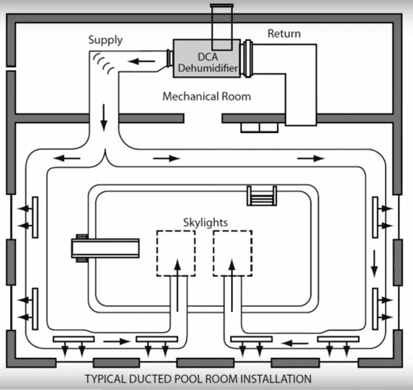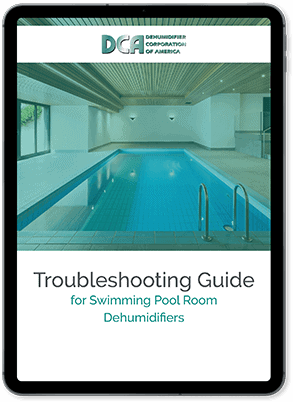A successful dehumidification system is comprised of two critical components: a dehumidifier appropriate for the particular application, which is dependent on a long list of parameters, and proper ductwork system installation. Without proper air flow through the dehumidifier and room being dehumidified, required space conditions cannot be achieved.
Dehumidification System Installation
Proper dehumidification system installation requires two more components in addition to the proper ductwork noted above: first, a consistent power source at the correct voltage and phase, and second, properly installed refrigerant connections between the dehumidifier and remote condenser.
Refer to the installation and service manual provided with your dehumidifier system to ensure that these components are each properly installed.
To maximize the efficiency of a dehumidification system, the ductwork must be well-designed and suited for the specific dehumidification system at hand. Outlined below are some of the main considerations to keep in mind when designing and installing ductwork for a successful dehumidification system.
Air Supply and Movement
Poorly designed or incorrectly sized ductwork can lead to dead air movement areas where moisture collects, causing corrosion and potentially dangerous structural weakness. Such environments also foster mold, mildew, dust mites, bacteria, and viruses, all of which have adverse — sometimes serious — effects on people’s health and wellbeing.
Ductwork that is poorly designed or sized can also result in damaging conditions, such as high head pressures or liquid floodback that can destroy a compressor. Both of these issues can void coverage under warranty.

When designing your system, start by ensuring the supply air will cover all exterior surfaces and specifically target locations where humidity causes the most problems, such as outside facing glass windows, skylights, and patio doors. Also, keep in mind that the ducting through unconditioned spaces requires the duct to be externally insulated.
However, in indoor pool rooms, the supply air must not be directed onto, but rather over, the water surface of the pool in limited amounts. Blowing air across an open indoor pool is not recommended in values over 30 fpm as it can increase the evaporation rate of the water, have a “chill effect” on patrons, and increase operating costs. However, it is still important for air quality and health reasons.
Good air distribution in a pool room environment is critical; providing proper mixing in the space helps prevent condensation, corrosion, and stratification. With adequate amounts of fresh air, proper ventilation, and sufficient supply air delivery rates, you can create a healthy and durable environment.
Spatial Considerations
When choosing the proper size for a dehumidifier, consider both the capacity needed and the physical dimensions of the dehumidifier. Don’t forget to plan for the dimensions of the ductwork attached to it. Supplemental heating equipment and other add-ons can further increase the amount of space required.
Weigh your options. In many cases, a vertical unit may seem like the ideal choice. However, horizontal units with vertical discharge may be the better option for applications with limited headroom.
Also, be sure to provide adequate clearance for service and maintenance of the unit. Finally, factor in the direction of the airflow after it leaves the dehumidifier, as this often determines optimal blower rotation.
Diffuser Location
The location of the return air diffusers is also very important. Return air should be taken near the source of the highest humidity area, which is often near the hot tub or spa. All diffusers must be ducted back to the dehumidifier.
If the dehumidifier is located in a mechanical room with a gas or oil pool heater, the mechanical room absolutely cannot be used as a plenum under any circumstances as it can be extremely hazardous. In applications involving skylights, the installation of ceiling fans operating in the A/C mode will provide air movement in the skylight shafts to prevent moisture buildup.
Proper Operation
Although it may seem obvious, it’s important to ensure the dehumidifier is operating properly.
Consider an indoor pool area’s air delivery ductwork system, which can be thought of as the arteries in a circulatory system. You may have a strong, healthy heart, but if the arteries are blocked, the heart can’t do its job properly. The same concept applies to ductwork; you may be using a top-quality dehumidifier, but if the dehumidifier ductwork is not properly executed the outcome will be disappointing.
Learn More
The ductwork recommendations outlined above are just a small sample of what must be considered in the overall design. Whatever final ductwork design you decide on, it must conform to the latest SMACNA and ASHRAE low-velocity duct standards. For more information on air delivery and dehumidifier ductwork installation, check out DCA’s comprehensive manual.
Or, to speak with an expert about your specific needs, reach out to the team at Dehumidifier Corp today. We provide top-quality dehumidifiers that can be easily integrated into existing systems, as well as brand-new constructions, and are well-versed on dehumidifier ductwork troubleshooting and best practices.
Topics: Ductwork Best Practices, Ductwork System Installation, Dehumidification system installation






